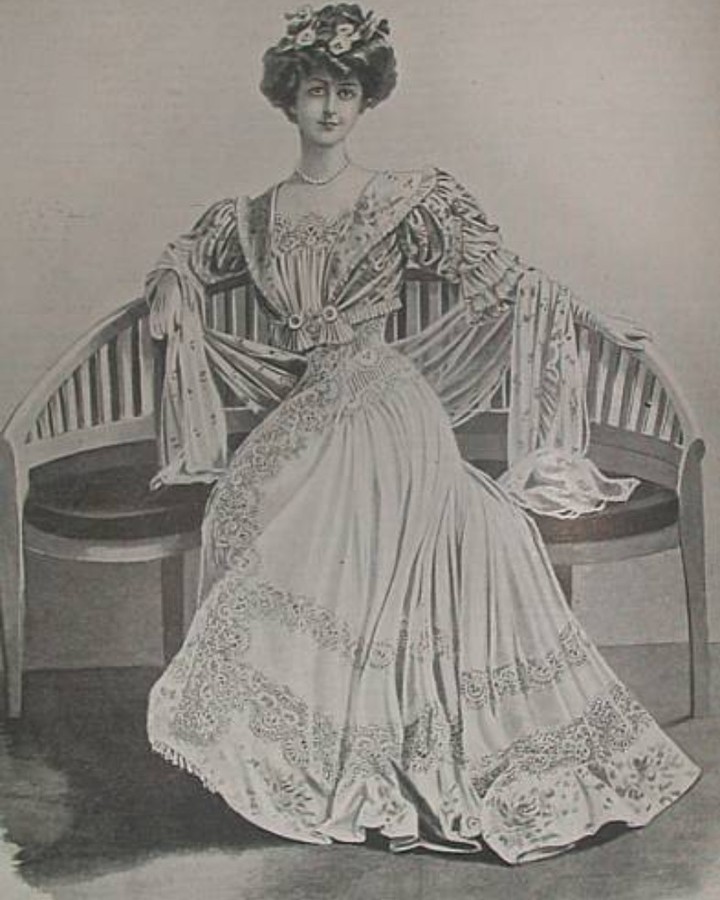Inspiration
I’ve been trying to make a more summer friendly wardrobe for some eras of interest and so have been looking in my Girl’s Own Paper articles from 1906-1911. So I just scanned the text for the fashion advice around this plate.
Girl’s Own Paper Vol. XXVIII- No 1404 NOVEMBER 24, 1906 Price One Penny
How a Girl Should Dress
My advice for December must be taken up, I think, for the greater part with evening gowns and wraps, for with Christmas comes a rush of gaiety for young people. It is really a fascinating subject—party frocks for girls -for never before have they been so pretty, and never do girls look prettier or more fascinating than in their dainty evening gowns.

Thin materials are worn so much more nowadays than they used to be; velveteens and cashmeres and nun’s veiling have given way to the finest voiles, thin silk, and a host of strange-named materials which are semi-transparent.
At the outset one takes it for granted that almost all evening gowns are made over silk slips, full “dropskirts” as the Americans call them, and semi-fitting bodice slips.
If a girl has a couple or so of good silk slips, one black and one white, the black one for dirty weather wear, it is astonishing how many different evening gowns she can have for very little money.
No. I to be worn over the white slip is of the finest white voile, so fine that it almost looks like chiffon, but it is no such thing. Trimmed round the full skirt with three cross-cut folds of delicately powdered chine silk, the flowers are merely suggested, not definite.
The fold at the foot is about five inches in width, the next one, about five inches higher, is about two and a half inches wide, and the top one, which is at an equal distance from the second one, is about three and a half inches wide; the narrowest is in the middle —this gives a new effect.
The full bodice should have a waistband, in a style to suit the individual, of powdered silk, and the puffed elbow sleeves kilted frills of the same.
No. 2 -evening frock for the white slip could be made in the same way, of either pale blue or -rose pink voile trimmed with satin of the same colour.
Pale pink looks particularly charming made like-this, for the mixture of the satin arid the thin material gives the effect and the shading of a bunch of roses. I know a girl who trimmed a pink voile evening gown with rose petals stitched on to the edges of the frills—artificial-petals it is needless to remark. It looked quite flower-like and youthful.
The third evening gown for the one white silk might be a of piece Valeciennes lace trimmed with tiny frills of the same, finished at the edges with ruchings of white satin ribbon.
And now for the black slip.
If you have a black voile gown use the idea of the three folds to remodel it.
Make the folds of very clear and not too narrow, striped black and white glace silk cut on the cross.
Braces of black and white on the bodice, and a tight fold round the end of the puff sleeve would quite transform a last year’s bodice.
Over the black slip you might also have a black crepe de Chine made with three deep flounces, graduated slightly
from the back towards the front, and kilted closely for about two inches downwards.
Have a kilted baby bodice trimmed with a deep bertha of some cobweb-like lace.
It is almost necessary to have at least one dark dress for the winter parties unless you are wealthy enough to do
as I heard an American millionairess did, wear a new tulle gown every evening and give it away the next day.
A white tulle gown needs dressing up too- white satin slippers, white silk stockings, and the daintiest of evening cloaks.
This is the age of perfect detail in dress, which doubles the expense, of course.
Formerly a reseda green velveteen, let us say, for a party frock, required nothing better than a pair of useful black slippers and open-work thread stockings.
To-day the same dress would demand green kid slippers of the exact tone of the gown, and if not kid, satin, and silk stockings to match.
Of course, it is much prettier especially for girls who are young enough to wear their dresses above -their
ankles.
With light gowns, too, gloves, slippers, stockings, fans, all must match.
Black gowns must have black elbow gloves, not tan, remember, and black satin slippers.
I think the most becoming and useful evening wrap for a girl is the Red Riding Hood cloak, slightly modified.
I saw one made of resada green fine cashmere, which had a most picturesque kilted hood, lined with pale blue silk; long cords and tassels of reseda green tied it on at the neck.
In white it also looks delightful with delicate blue pink or pale green hood linings.
Light, warm cloaks are so much better than heavy ones, for weighty evening wraps do more to destroy the freshness of ones evening bodices than any amount of indoor wear.
Over my newest and most easily crushed evening bodices I always wear my lightest cloak, and keep myself warm below by folding a lace or chiffon scarf over my neck and shoulders.
It is really amazing how warm chiffon is. I find a motor veil wrapped round my neck is quite as warm as a knitted scarf.